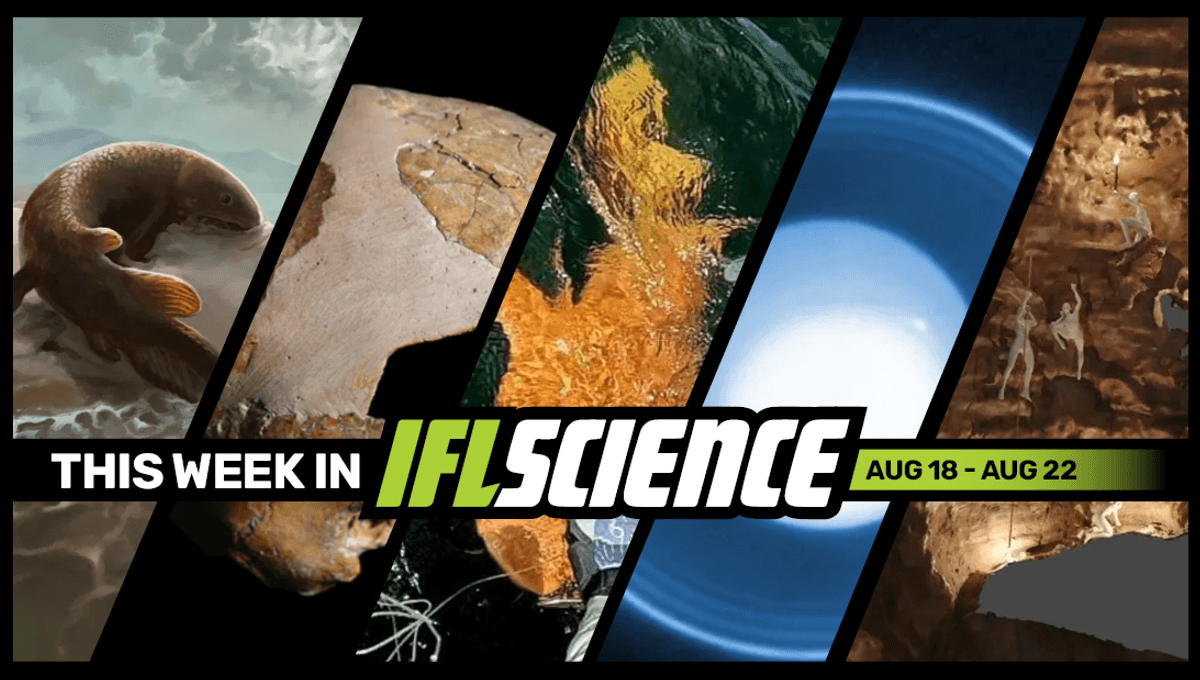
This week, a 5-year-old child who lived 140,000 years ago is the earliest evidence of interbreeding between Neanderthals and Homo sapiens, the first-ever recorded case of xanthism in nurse sharks has been seen in a bright orange individual spotted off the coast of Costa Rica, and 16,000-year-old paintings found deep inside a perilously inaccessible cave suggests prehistoric humans risked their lives to enter. Finally, we explore what ancient people thought when they discovered the remains of extinct species.
The rest of this article is behind a paywall. Please sign in or subscribe to access the full content.
Create an IFLScience account to get all the biggest science news delivered straight to your inbox every Wednesday and Saturday.
New Fossil Trackways Reveal Fish Left The Ocean 10 Million Years Earlier Than Thought
Trails left in ancient rock have been attributed to fish getting the hang of the then-newfangled concept of crawling. If correct, this would push back the conquest of the land by vertebrates by 10 million years. That’s assuming these pioneers didn’t just nope it out back to the water (like whales later would), until braver souls (or soles) tried again. Read the full story here
Neanderthals And Homo Sapiens Got It On 100,000 Years Earlier Than We Thought
Around 140,000 years ago, a Neanderthal and a modern human got it on. We know nothing about the situation that led to this interaction. We don’t know which parent came from which species, but we do know that they had a child who died around the age of five. A team of researchers from Tel Aviv University and the French National Centre for Scientific Research discovered the child’s skeleton in what is being hailed as a “global breakthrough”. Why is it so significant? This is the earliest evidence we have of these two distinct human groups interbreeding. Read the full story here
First-of-Its-Kind Bright Orange Nurse Shark Recorded Off Costa Rica Makes History
Let’s face it, the sea is full of proper freaky looking creatures, from Barbie lobsters to disco worms and everything in between. However, normally in the shark world, the species relies on sharp teeth and speed to make an impression. Well, one shark species has taken a rather different approach from stealthy gray. For the first time, a nurse shark has been recorded in the Caribbean being bright orange. Read the full story here
JWST Spots Tiny New Moon Just Outside Uranus’s Rings, Bringing Total To 29
JWST has spotted the 29th moon of Uranus, finding an object that’s probably the size of a small city 2.7 billion kilometers away. Within six years of discovering Uranus, William Herschel had found two moons. Although Herschel thought he had found four more, it took 64 years before the next two real discoveries. In the 135 further years before Voyager 2 visited the system, only one more moon was found, but in the last 40 years, the pace has picked up dramatically. Read the full story here
16,000-Year-Old Paintings Suggest Prehistoric Humans Risked Their Lives To Enter “Shaman Training Cave”
Prehistoric paintings found deep inside a perilously inaccessible cave in the French Pyrenees reveal how ancient hunter-gatherers risked their necks to conduct ritual activities in the bowels of the Earth. Known as Etxeberri Cave, the site is considered one of the most challenging caverns to have been explored by Palaeolithic humans, and may have been decorated as part of a death-defying initiation undertaken by aspiring shamans. Read the full story here
TWIS is published weekly on our Linkedin page, join us there for even more content.
Feature of the week:
What Did Ancient People Think When They Found Fossils?
If you’ve ever seen a mammoth skull, you’ll have noticed the gaping nasal cavity that sits front and center, like a giant, singular eye socket. Without knowing what the animal looked like when it was alive, you’d swear that the thing was an enormous one-eyed monster, so it’s hardly surprising that these fossilized pachyderm remains were once interpreted as cyclops skeletons. However, other ancient people were surprisingly clear that what they saw were the bones of creatures that no longer existed. Read the full story here
More content:
Have you seen our e-magazine, CURIOUS? Issue 37 (August 2025) is available now. This month, we asked, “Are There Body Parts You Can Live Without?” – check it out for exclusive interviews, book excerpts, long reads, and more.
PLUS, the We Have Questions podcast – an audio version of our coveted CURIOUS e-magazine column – continues. In episode 11, we ask, “Why Are Yawns Contagious?”
The Big Questions podcast has returned, and we’re continuing season 5 with episode 5’s big question: Will We Ever Have A Universal Flu Vaccine?
Source Link: Fish Left The Ocean 10 Million Years Earlier Than Thought, JWST Spots Tiny New Moon Just Outside Uranus's Rings, And Much More This Week